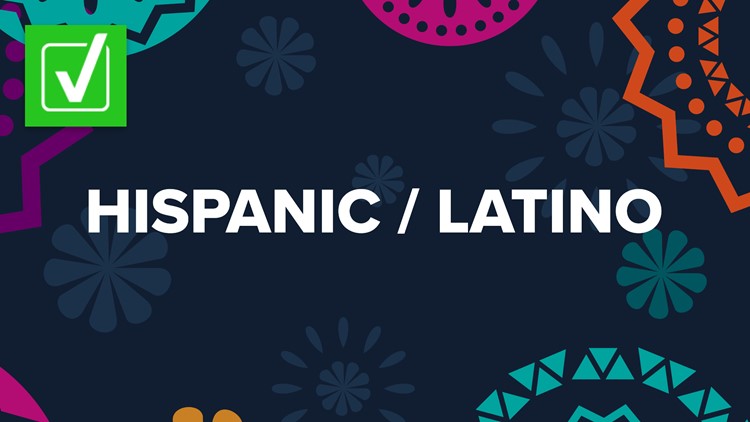Each year, National Hispanic Heritage Month is celebrated from Sept. 15 to Oct. 15. The month honors the history, culture and contributions of Americans who were born in or have heritage from Spain, Mexico, Central America, the Caribbean and/or South America.
But not everyone in that population calls themselves Hispanic. Popular Google searches at the start of this Hispanic Heritage Month include questions about the differences between Hispanic and Latino/a/x, and whether Portuguese-speaking Brazil is included in the month’s celebrations.
THE QUESTION
Is there a difference between the terms Hispanic and Latino?
THE SOURCES
Definitions for “Hispanic” and “Latino” in Cambridge English Dictionary, Merriam-Webster Dictionary and on Dictionary.com
Facing History & Ourselves, a nonprofit that helps educators prepare students for civic life and to stand up to bigotry
Latinx 4 Social Movement, a non-profit providing services to the Los Angeles Latinx Community
Carlos Colombo, founding partner of immigration law firm Colombo & Hurd, PL
THE ANSWER
Yes, “Hispanic” and “Latino” mean different things. “Hispanic” is linked to language while “Latino” is linked to culture or geography. The two terms have a lot of overlap and are often used interchangeably.
WHAT WE FOUND
The definition of Hispanic in the Cambridge English Dictionary is: “from or connected with Spanish-speaking countries, especially those in Latin America, or having parents or grandparents from these countries.” The Dictionary.com definition similarly reads: “of or relating to Spanish-speaking Latin America.”
The definition of Latino in the Cambridge English Dictionary is: “someone who lives in the U.S. and who comes from, or whose family comes from, Latin America.” Again, the Dictionary.com definition is similar: “of or relating to people of Latin American origin or descent, especially those living in the United States.”
The main difference between the two words is that Hispanic generally refers to Spanish-speaking Latin America and Spain, while Latino/a/x typically refers to Latin American countries and cultures, regardless of whether the culture or person speaks Spanish, Dictionary.com says.
These two groups heavily overlap. Latin America, depending on the definition, refers to some or all of the countries and territories in Central America, South America and the Caribbean. Most of the countries in Central and South America — 17 out of 21 in total — speak Spanish as their official or most-spoken language. Several other countries in the Caribbean and territories in the region also speak Spanish.
Because of this, many people use these terms interchangeably. For example, the U.S. Census Bureau defines a person of “Hispanic or Latino origin” as a person of a South or Central American Spanish-speaking culture, regardless of race.
The 1980 Census was the first to gather information about the Spanish-speaking community with a question about people of Hispanic origin, the Census Bureau says. The 2000 Census later became the first census to ask about Hispanic and Latino people together.
Merriam-Webster defines the words almost identically, although it gives both words definitions similar to the traditional definition for Latino/a/x. It defines a Latino as “a person of Latin American origin living in the U.S.” Merriam-Webster defines Hispanic as a word “of, relating to, or being a person of Latin American descent and especially of Cuban, Mexican, or Puerto Rican origin living in the U.S.”
Some people in Spanish-speaking communities around the U.S. use Hispanic and Latino/a/x interchangeably, or otherwise have no preference for one term over the other.
“In more than 15 years of polling by Pew Research Center, half of Americans who trace their roots to Spanish-speaking Latin America and Spain have consistently said they have no preference for either Hispanic or Latino as a term to describe the group,” the Pew Research Center says.
But that’s not true of everyone. Not only do some people have a preference for one term over another, but some don’t identify with either term at all. Instead, they prefer to identify themselves by country of origin, such as Mexican or Cuban, the Pew Research Center has found.
“We have very diverse cultures within the Hispanic community,” said Carlos Colombo, founding partner of immigration law firm Colombo & Hurd, PL. “And sometimes, if you're not Hispanic or Latino, you don't really understand that being from Mexico — the culture there may be very different than being from Argentina, or Venezuela or other parts of the continent.”
Not all Latin American cultures speak Spanish, adding further diversity to an already incredibly diverse community. “Latino” emerged as a popular alternative to “Hispanic” in part because it’s inclusive of Latin American cultures that don’t speak Spanish, says Facing History & Ourselves, a nonprofit that helps educators prepare students for civic life and to stand up to bigotry.
But how someone defines “Latin America,” and therefore identifies those within the Latino/a/x community, can be complicated.
A common definition of Latin America, and the one used by the American Historical Association (AHA), defines the region as the countries and territories of Central America, South America and the Caribbean that speak a language descended from Latin as their official or most-spoken language. Those languages are Spanish, French and Portuguese.
The AHA’s definition of Latin America therefore includes South America’s largest and most populous country, Brazil, which speaks Portuguese as its official and most-spoken language. It also includes Haiti, which speaks French as an official language.
However, the AHA’s Latin America does not include Belize, a country on Mexico’s southern border that speaks English as its official language, or Suriname, a country on Brazil’s border that speaks Dutch as an official language.
In the 2020 Census, more than two-thirds of all Brazilians in the U.S. described themselves as Hispanic or Latino, the Pew Research Center says. Pew says 41% of people with ancestry from Belize and 3% of people with heritage from Caribbean countries that don’t speak Spanish considered themselves Hispanic or Latino in the 2020 Census.
The Census Bureau does not count people from Brazil, Belize or Haiti as “Hispanic or Latino,” Pew Research Center says, and therefore typically removes these people from its count of the “Hispanic or Latino” population.
The Census Bureau then counts people with heritage from Spanish-speaking Latin American countries as “Hispanic or Latino,” even though the Pew Research Center says an estimated 11% of people with such heritage do not identify as Hispanic or Latino.
Some people prefer the terms “Latinx” or “Latine” instead of Latino or Latina because Latino and Latina are gendered words, and they feel the non-gendered variations are more inclusive, says Latinx 4 Social Movement, a non-profit providing services to the Los Angeles Latinx Community. However, “Latinx” can be controversial to some people since Spanish words don’t naturally end with an X, Latinx 4 Social Movement says.



